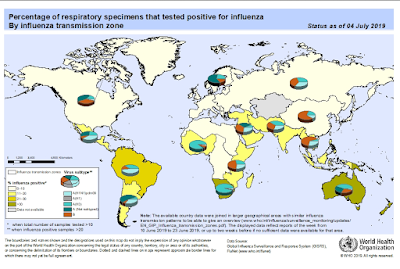#14,173
Although it is summer north of the equator, and flu activity there is minimal, in the temperate zones of the Southern Hemisphere it is the heart of flu season. And by many reports (see below), it has been an unusually early and active one.
New Zealand Restricts Flu Vaccines As Supplies Runs Short
WHO Global Influenza Update #342
Australia: An Early Surge In Flu CasesAs always, Dr. Ian Mackay in his Virology Down Under blog, continues to provide the best and most reasoned coverage of Australia's unusual flu season.
Despite the sometimes hyperbolic media coverage, we are seeing some hopeful signs that flu may have peaked in some regions, although Australia's season is far from over.
H3N2 is reportedly the main culprit in Australia and New Zealand - while in South America, H1N1 appears to be king of the viral hill.Yesterday the World Health Organization published their latest global influenza report - current through June 24rd - which found an increasingly quiet Northern Hemisphere, but continues to report heavy flu activity in many of the temperate zones south of the equator.
First some excerpts from that report, and then I'll return with a postscript:
Influenza update - 345
08 July 2019 - Update number 345, based on data up to 23 June 2019
Information in this report is categorized by influenza transmission zones, which are geographical groups of countries, areas or territories with similar influenza transmission patterns. For more information on influenza transmission zones, see the link below:
Open map in new window
jpg, 448kb
Summary
- In the temperate zones of the southern hemisphere, influenza detections continued to increase or remained elevated in most areas.
- The 2019 influenza season has started earlier than previous years in Australia, Chile, South Africa and New Zealand.
- Influenza A(H3N2) viruses predominated in Oceania and South Africa.
- Influenza A(H1N1)pdm09 viruses predominated in temperate South America.
- In Southern Asia and South East Asia, influenza activity was low across reporting countries, except Myanmar where an increase in influenza A(H1N1) was reported.
- In the Caribbean, Central American countries, and the tropical countries of South America, influenza and RSV activity were low in general, with exception of Costa Rica and Panama where influenza A viruses activity was high
- In Northern, Eastern, West and Middle Africa, influenza activity was low across reporting countries.
- In the temperate zone of the northern hemisphere influenza activity returned to inter-seasonal level in most countries.
- Worldwide, seasonal influenza A viruses accounted for the majority of detections.
National Influenza Centres (NICs) and other national influenza laboratories from 91 countries, areas or territories reported data to FluNet for the time period from 10 June 2019 to 23 June 2019 (data as of 2019-07-04 13:50:17 UTC).The WHO GISRS laboratories tested more than 68851 specimens during that time period. 6853 were positive for influenza viruses, of which 4387 (64%) were typed as influenza A and 2466 (36%) as influenza B. Of the sub-typed influenza A viruses, 972 (36.1%) were influenza A(H1N1)pdm09 and 1717 (63.9%) were influenza A(H3N2). Of the characterized B viruses, 48 (4%) belonged to the B-Yamagata lineage and 1144 (96%) to the B-Victoria lineage.
(Continue . . . )
With the Northern Hemisphere's flu season only a few months away we tend to look at flu activity south of the equator to try to glean what kind of flu year to expect. Unfortunately, influenza isn't nearly that predictable.
Last year, Australia enjoyed an unusually light flu season, which many took as a good omen.Yet last winter, the United States saw a moderately severe season. One that started off relatively mild, but ramped up when a new clade (3C.3a) of H3N2 took off (see MMWR: Influenza Activity in the United States During the 2018–19 Season).
 |
| Credit CDC - 2018/2019 Flu Season Severity |
Influenza seasons can turn on a dime, as illustrated by the chart above. Until January, we appeared to be on track for a mild flu year. That is, until H1N1 was over taken by H3N2.
While the circulating 2009 H1N1 subtype is fairly young and relatively stable, H3N2 has been around for more than 50 years - has split into numerous clades (see ECDC: Influenza Virus Characterisation, May 2019) - and has become increasingly unstable.
Predicting what flu will do tomorrow is a mug's game, much less what it will do 6 months from now.About all we can do is take reasonable precautions (get the flu vaccine, use good hand hygiene, etc.), see how things unfold, and be prepared for surprises.
